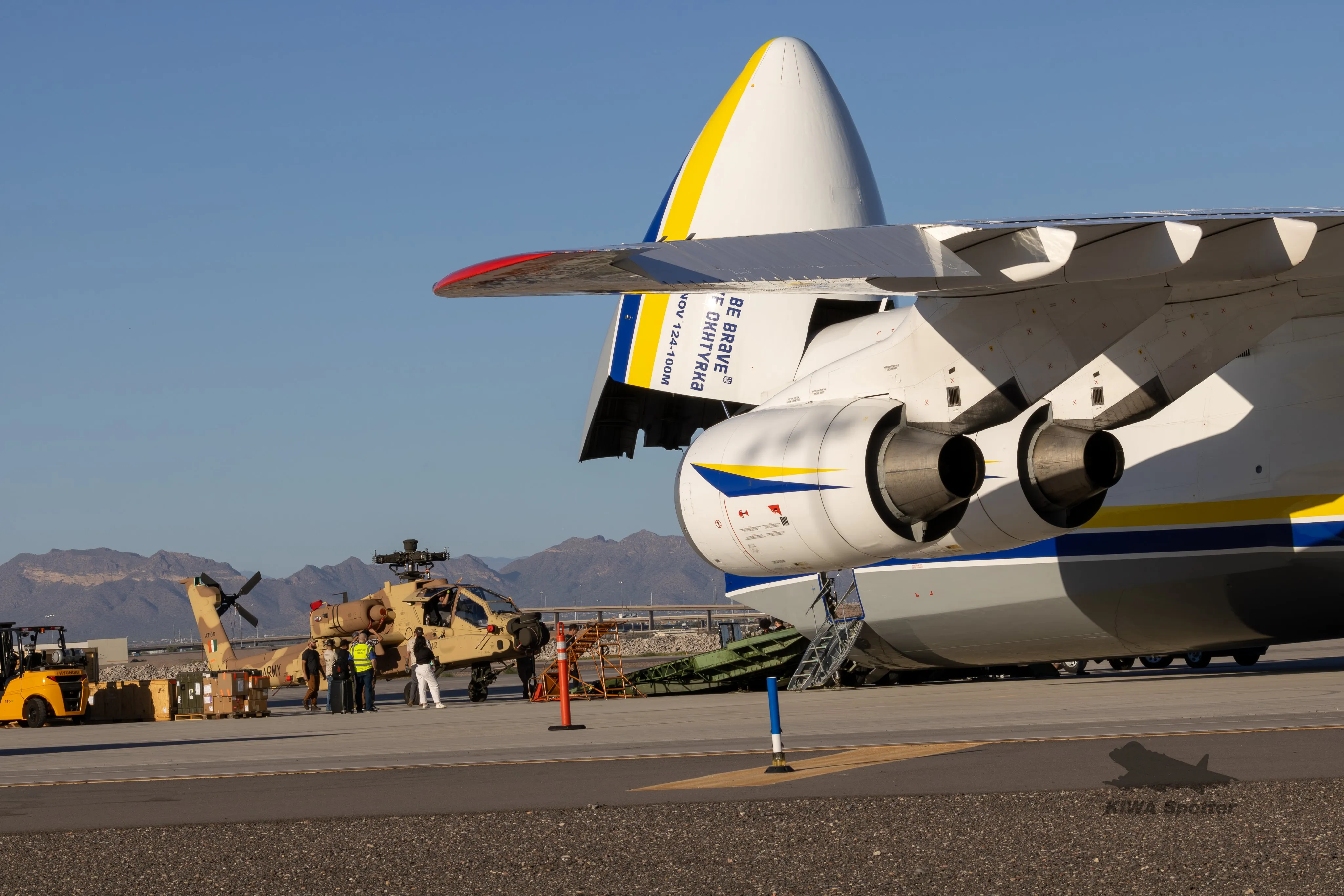The planned delivery of three AH-64E Apache Guardian attack helicopters to the Indian Army has taken an unusual turn. The Antonov Airlines An-124 cargo aircraft carrying the rotorcraft to India returned to the United States with the Apaches still onboard, after a long stopover in the United Kingdom. A Boeing spokesperson told TWZ that the company was looking into “logistical issues” that they said had interrupted the transportation.
The unexpected movements were tracked by plane spotter @KiwaSpotter, who noted the heavy-lift An-124 serial UR-82008 arriving at Mesa Gateway Airport, also known as Phoenix–Mesa Airport, in Arizona, on October 30, after a flight from its operating base in Leipzig, Germany.

After being moved from the nearby Boeing facility in Mesa, the Apaches were loaded aboard the An-124, which then departed the United States on November 1 and flew to East Midlands Airport in England. When loaded, the helicopters were already painted in their distinctive Indian Army desert camouflage scheme. At least one of the Apaches could be identified in the photos, as serial IA-7105.
The An-124 and its Apache cargo then remained on the ground at the British airport for eight days before the aircraft departed, not headed toward India but returning over the Atlantic to its original point of departure at Mesa Gateway Airport, where they touched down on November 8.
The Apaches were later seen after being unloaded, now under tow, with their rotors removed.
The Indian Army has already received its first three AH-64Es in July this year, part of a six-aircraft deal worth $796 million that was signed back in February 2020, during U.S. President Donald Trump’s visit to New Delhi.
The first trio of rotorcraft was flown by Antonov Airlines An-124 to Air Force Station Hindon.
“These … helicopters will enhance the Army Aviation wing’s operational effectiveness, especially in challenging terrains,” Indian Minister of Defense Rajnath Singh said at the time.
These AH-64s are currently being used to train crews at Nashik, in Maharashtra state, western India, home of the Indian Army Aviation Training School. Ultimately, the Indian Army Apaches are expected to be stationed at Nagtalao Army Aviation Base, north of Jodhpur, in northwestern India.
The latest batch of three helicopters would have completed the Indian Army deliveries… had they arrived.
TWZ approached Boeing for more information, and a company spokesperson provided the following statement:
“We are currently addressing logistical issues caused by external factors to complete the delivery process for the remaining aircraft. We remain closely engaged with the U.S. government and Indian Army and continue working to execute our contract as expeditiously as possible to meet India’s needs and fleet requirements.”

It remains unclear what the exact nature of the problem was, and whether it was related to the Apaches, the An-124 carrying them, or some other factor in their long aerial transport to India. Potentially, “logistical issues” could involve something technical, relating to any of the aircraft involved, but they might also involve something more mundane, perhaps related to customs or other paperwork. There’s even the potential for some kind of diplomatic or political interference in the transport process, although it would be a little surprising if this wasn’t signaled in advance.
Unusually, New Delhi has ordered AH-64Es for two different armed services.
Previously, 22 Apaches were ordered by the Indian Air Force, and all have been successfully delivered.

The current delay in delivery comes amid New Delhi’s increasing willingness to buy new military aircraft from the United States. Other aircraft acquisitions in this category include the C-130J Hercules transport aircraft, the CH-47F Chinook heavy-lift helicopter, and the P-8I Neptune maritime patrol aircraft (as the Poseidon is locally known).
At the same time, there have been increasing strains in U.S.-India politics of late. Within India, there have been growing questions about the reliability of the United States as a strategic partner. Tensions worsened after the terrorist attack in India in April and the ensuing India-Pakistan military clashes, after which the Trump administration imposed a 50 percent tariff against India. These penalties also reflected U.S. displeasure about continued Indian purchases of Russian oil.
What is clear is the Indian Armed Forces’ urgent need to bolster its attack helicopter capabilities, especially as it seeks to better counter its increasingly high-tech adversaries — chiefly China and Pakistan.
The same Boeing spokesperson told TWZ that the company plans to complete the delivery of the remaining Apaches on order for the Indian Army as soon as possible. We will continue to track this story and the eventual fate of the three AH-64s that the service is still waiting for.
Contact the author: [email protected]
